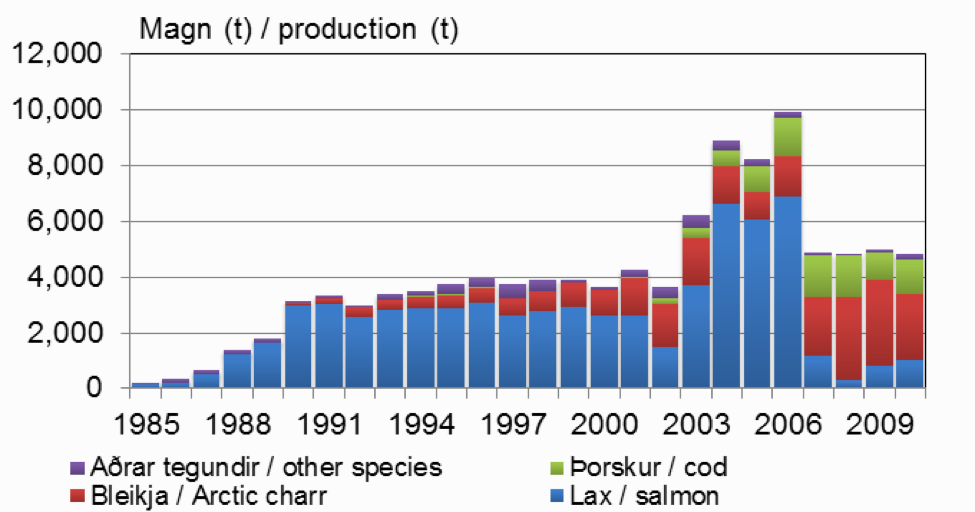A Rise in Aquaculture

In the land of Fire and Ice, agriculture and animal husbandry has proven to be difficult in such a hostile land. It is no surprise Icelanders turned to the riches of sea to provide the foundation of their economy, culture and livelihoods since settlement.
However, in recent years global wild fish stocks have been diminishing at alarming rates and fish catches have reached or surpassed the limits of what the natural ecosystem can provide (2). For a nation so dependent on fish exports, new solutions needed to be explored one being the cultivation of fish via aquaculture.
The start of a new era
Iceland has huge potential for aquaculture due to its vast availability of fresh and salt water as well as unlimited geothermal heat (1). Some evidence in Icelandic Sagas suggest aquaculture may have been explored as early as 1883 (1), but the first real attempt at rearing fish began around the 1900s through the hatching and release of salmonid fry into rivers (4). Later in 1951 a small-scale fish farm company called Laxalón imported and reared rainbow trout, paving the way for the larger-scale salmonid farms that followed in the year to come (4).
A success? Not so much…
Unfortunately salmon farms were unsuccessful in developing economic sustainability and most went bankrupt in the 1990s due to low market prices and the difficulty/expense of production (1)(4) . This inspired more research into rearing of fish species and in the 2000s farming of species such as atlantic salmon, arctic char and atlantic cod increased (4). A short period relative success occurred around 2006 when total aquaculture production in Iceland reached over 8,300 tonnes but in the following year production dropped by nearly half to 4,800 tonnes (3).

Is it helping?
Aquaculture is sometimes seen as a way to release fishing pressure on wild stocks, therefore benefitting environment, however the reality is not so clear cut. Environmental issues pertaining to aquaculture are many including:
- Excess food and excreta impact coastal water quality
- Fish oil from wild fish products is often used to rear fish
- Lack of successful hatcheries results in capture of wild fish seed
- Risk of cultured fish escaping and spreading harmful genes or diseases (5)
To address these concerns, there are specific Icelandic legislation and licensing that fish farms need to adhere to but they cannot completely eliminate the environmental problems associated with aquaculture production.
A way forward
It is clear that there is no easy solution to supplying to world with sustainable fish sources. I think it is fair to say that Iceland is a ways away from achieving a sustainable aquaculture industry due to the economic hardships of production, and harmful production practices. But with more research and better legislation in place there could be hope yet. In the meantime I think Iceland’s focus should remain on improving the sustainability of their fishing industry that they still heavily depend on.
Sources Consulted
- Kristinsson, Júlíus B. “Aquaculture in Iceland – History and Present Status.” Icel. Agri. Sci. 6 (1992): 5-8.
- Beveridge, M. C. M., S. H. Thilsted, M. J. Phillips, M. Metian, M. Troell, and S. J. Hall. “Meeting the Food and Nutrition Needs of the Poor: The Role of Fish and the Opportunities and Challenges Emerging from the Rise of Aquaculturea.” Journal of Fish Biology 83 (2013): 1067-084.
- “Part I Statistics and Main Indicators.” FAO Fisheries & Aquaculture – Country Profile. Food and Agriculture Organization of the United Nations, n.d. <http://www.fao.org/fishery/facp/ISL/en>.
- Gunnarsson, Valdimar Ingi. “Aquaculture.” Icelandic Fisheries. Ministry of Fisheries and Agriculture, n.d. Web. 19 June 2017. <http://www.fisheries.is/aquaculture>.
- Schram, Jón G. “Cage Fish Farming in Coastal Waters; History, Success, Environmental Aspects and Future Prospects.” Sustainable Uses of Icelandic Coastal Zones Opportunities and Threats. University Centre of the Westfjords, n.d. <http://www.uw.is/skraarsafn/skra/106/>.